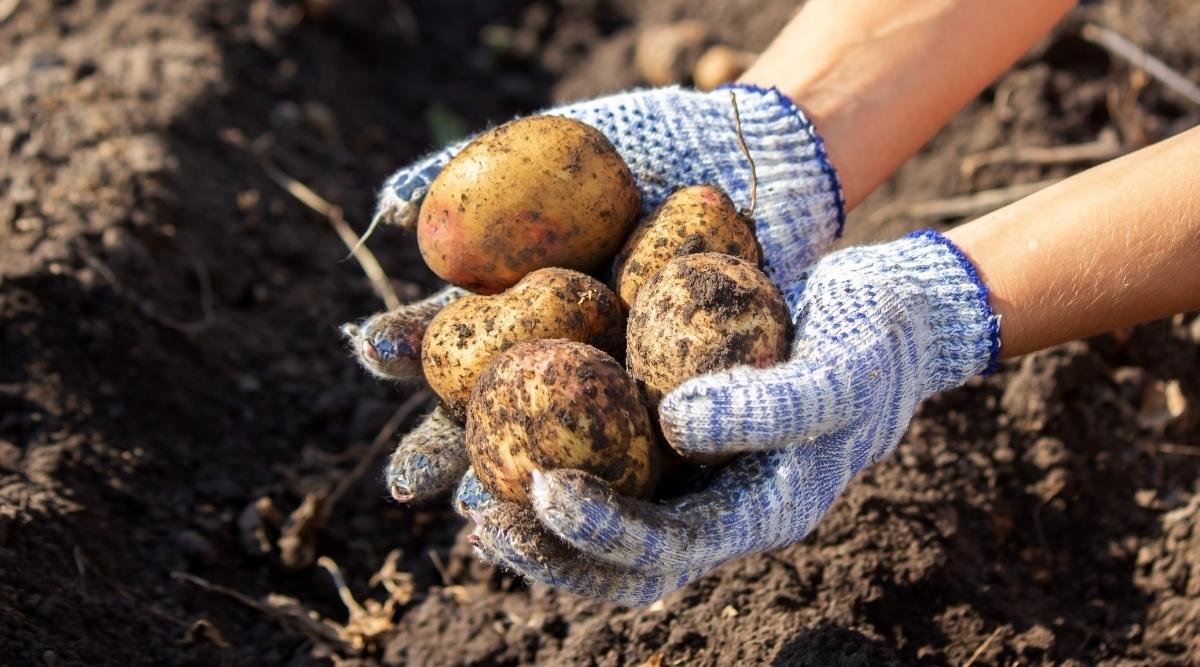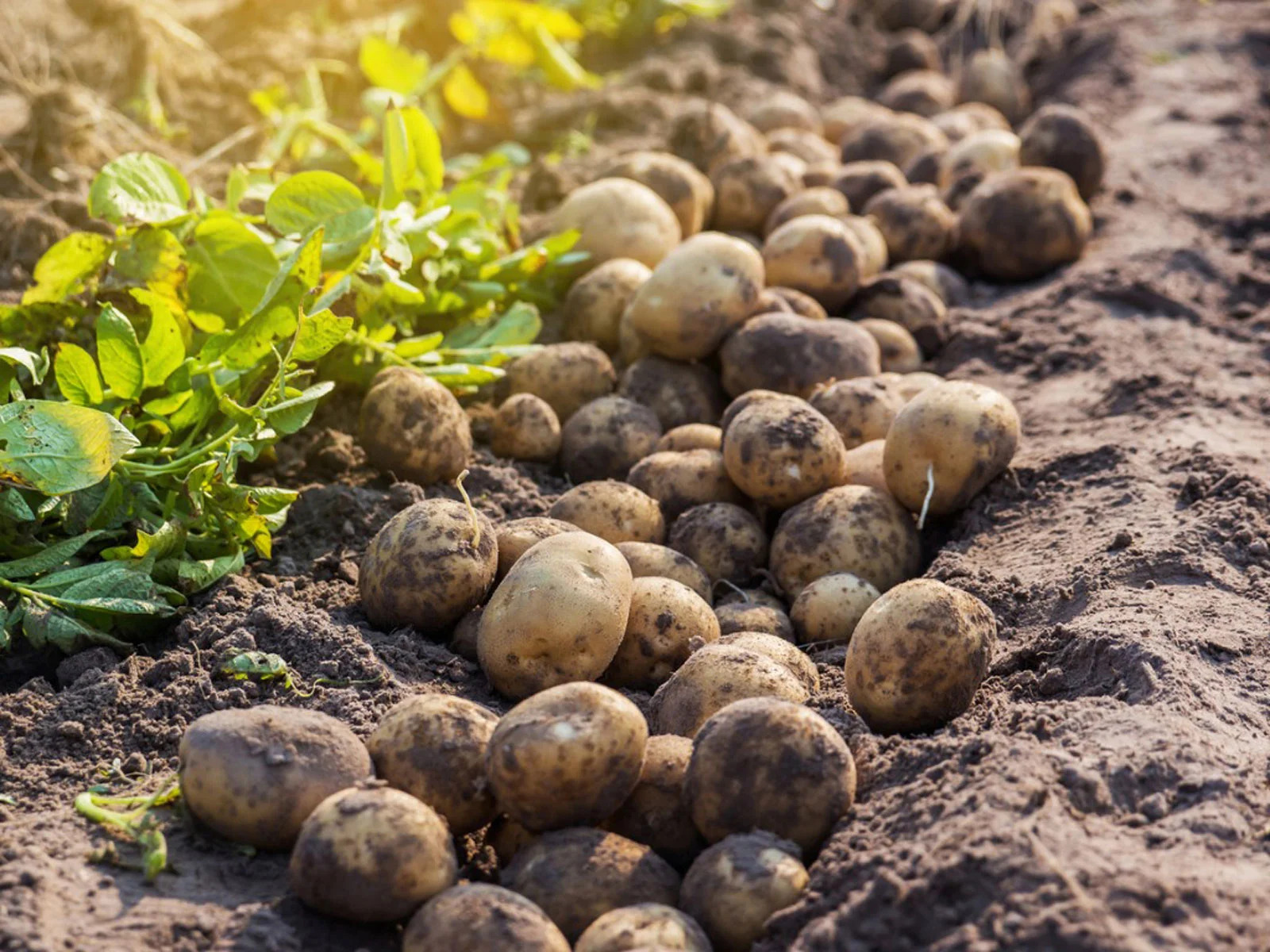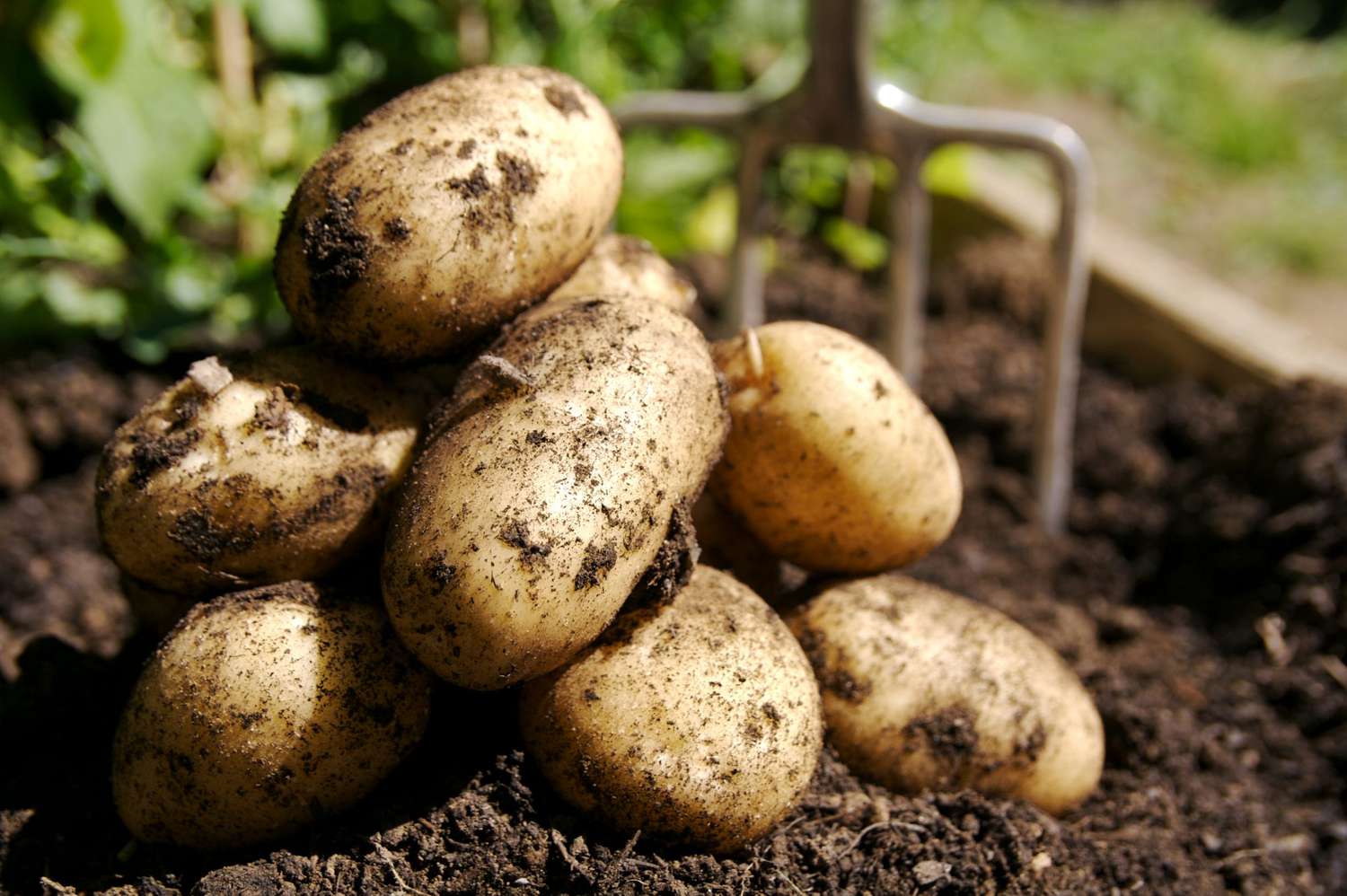When To Harvest Potatoes
Harvesting potatoes at the right time is crucial for a successful crop. Knowing when to harvest your potatoes can mean the difference between a bumper crop and a disappointing one. Timing is influenced by various factors such as potato variety, weather conditions, and the intended use of the potatoes.
The ideal time to harvest potatoes depends on the potato variety and the purpose for which they are being grown, whether for storage, immediate consumption, or seed production. Early-season potatoes, like new potatoes, can be harvested once the plants have flowered, and the leaves have started to yellow. These potatoes have thin skins, are delicate, and best eaten soon after harvesting.
Two Main Types of Potatoes
Potatoes are a staple food across the world. They are delicious, nutritious, and versatile, making them a valuable addition to any diet. There are two main types of potatoes: early potatoes and maincrop varieties, each with their unique characteristics and uses.
Early potatoes are the first to be harvested, and they're usually ready for consumption in late spring or early summer. First early potatoes are the earliest of all the potatoes, and they have a thin skin that makes them easy to peel. They are also known for their tender flesh, which is perfect for boiling or roasting. Second early potatoes, on the other hand, have a slightly thicker skin and firmer flesh, making them ideal for frying or mashing.
Maincrop varieties, as their name suggests, take longer to mature and are usually harvested in late summer or early fall. They are bigger than early potatoes, with thicker skins and denser flesh. Maincrop potatoes have a longer shelf life and are more suitable for storing. They are perfect for use in stews and soups that require a stronger potato flavor.
When to Harvest First Early Potatoes
Planting seed potatoes is one of the most enjoyable gardening activities. Especially when it comes to first early potatoes, you can enjoy the flavors of small and tender-skinned potatoes much earlier than the maincrop varieties. But when is the best time to dig up these delightful spuds?
First early potatoes are typically planted in early spring, usually from mid-March to mid-April, depending on your area's soil temperatures and weather conditions. The expected time to crop is from late May to June, about 10-12 weeks after planting.
As the potatoes grow, you'll notice that they develop small tubers, and this is when you should start checking regularly for signs of readiness for harvest. Typically, the size of first early potatoes is less than 2 inches in diameter, with a delicate and scrumptious taste that's perfect for salads or roasting.
To know if your first early potatoes are ready for harvesting, gently lift the plant's foliage or dig around the plant just an inch below the soil level with a garden fork. If the potatoes are roughly the size of an egg or larger, they are ready to harvest. However, if they are smaller than that, give them a couple of weeks to mature.
First early potatoes come in various varieties, such as 'Rocket,' 'Arran Pilot,' and 'Casablanca.' These varieties are particularly suited for early planting time and can provide a fantastic yield of small, sweet, and tender potatoes.
When to Harvest Second Early Potatoes
Second early potatoes are a popular choice for many home gardeners due to their unique characteristics and growing requirements. These potatoes are typically planted in early to mid-spring and mature in 110-120 days. They are known for their smooth skin, tender texture, and delicious taste.
One of the most important things to consider when harvesting second early potatoes is maturity signs. You can tell if your potatoes are mature by keeping an eye out for the blooming and dropping of buds. When the plants begin to flower, it signals that the tubers are starting to mature. Once the blooms start to fall off and the leaves begin to yellow and die back, it's time to start thinking about harvesting.
There are many popular varieties of second early potatoes that can be planted and grown. Some of the most popular include Charlotte, Rocket, and Maris Peer. Each variety has its own unique flavor, texture, and appearance, so choose one that best fits your preferences and growing conditions.
The ideal time to harvest second early potatoes for the best yield is approximately 2-3 weeks after flowering has ceased. This will ensure that the potatoes have reached their maximum size and are still tender and delicious. You can harvest by gently digging into the soil around the plants with a garden fork, being careful not to damage the tubers. Once you have harvested your potatoes, it's important to let them cure for a few days to toughen up the skin and improve storage life.
When to Harvest Maincrop Potatoes
Maincrop potatoes are varieties that take longer to mature than first or second early potatoes, but produce larger yields. They can be planted around the same time as second earlies and are harvested in late summer, from August to September. When it comes to harvesting maincrop potatoes, there are a number of factors to look for to know when they are ready to be dug up.
One of the first signs to look for is changes in the foliage of the plant. As the potatoes reach maturity, the leaves and stems will begin to turn yellow and wilt. This is a signal that the plant is preparing to die back and the tubers are fully developed. You can also wait for the plants to flower, which is a good indicator that the growing process is nearing its end. The flowering also helps when deciding which are seed potatoes for the following year.
Once you have seen the yellowing and wilting of the foliage, it's important to dry out the soil before harvesting. This can be done by lifting the tubers gently with a garden fork and leaving them on the surface of the ground for a few hours to allow them to dry naturally.
After drying, the potatoes can be harvested by carefully inserting a fork or spade under the plant and lifting it, being careful not to damage any of the tubers. Gently brush off any soil that clings to the potatoes and leave them to cure for about two weeks, which allows the skin to toughen up. This process helps the potatoes last longer in storage.
What do Potato Plants Look Like when Ready to Harvest
When it comes to harvesting potatoes, knowing when to dig them up is crucial. The physical appearance of the potato plant can give valuable clues about when the potato tubers are ready to harvest.
One indication is the foliage and stems of the potato plant. The potato plant should have died back and turned brown. This typically happens sometime after the plant has bloomed (if it's a blooming variety). The browning and wilting of the foliage and stems signal the nutrients have stopped flowing to the tubers, meaning they are mature and ready for harvest.
Another visual cue is the size of the potato. If you dig up one plant, you should find at least one decent-sized potato waiting just below the soil around the base of the plant. The size of the potatoes will vary depending on the variety of potatoes you are growing.
Harvesting Potatoes
Harvesting potatoes can be a fulfilling experience for any gardener, but knowing when to dig them up is essential for a successful harvest. Whether you're growing them in containers or in a garden bed, the timing of your potato harvest will depend on factors such as the potato variety, soil temperatures, and even weather conditions.
Knowing When Your Potato Tubers are Ready to Harvest
If you are a potato grower, one of the most important things to know is how to tell when your potato tubers are ready to harvest. The best time to dig up your potatoes depends on several factors, including the potato variety, soil temperatures, and the growth phase of the potato plant.
Potatoes go through different growth phases, and the timing of these phases can vary depending on the variety and the growing conditions. One key indicator that potatoes are ready for harvest is when the plant develops flowers. After the flowering stage, the plant canopy will eventually start to die back, which is another sign that it's time to harvest. This is especially true for maincrop potatoes.
If you are growing new potatoes, you can start harvesting them a couple of weeks after the plants have finished flowering. New potatoes are smaller and have a tender skin, and they are typically harvested before the plant canopy dies back.
Another way to assess whether potato tubers are ready for harvest is by gently digging around the base of the plant with a garden fork. If the tubers are around 1-2 inches deep and the skin is firm, you can start harvesting them. However, if the skin is still soft, it's best to wait a little longer.
Warning Signs of Unripe Tubers in the Ground
Harvesting too early can result in small and underdeveloped tubers, while harvesting too late can cause tubers to rot or develop other issues that negatively impact the yield and quality of the crop. That's why it's important to keep an eye out for the warning signs that your potato tubers are not mature and ready for harvest.
One of the first things to look out for when checking if your potatoes are ready to harvest is the maturity of the skin on the tuber. Mature potato skins are typically thick and tough, and can resist rubbing off or scratching easily. If the skin on your potatoes is still thin and papery, it's a good sign that the tubers are not quite ready for harvest. That's because the skin serves as a protective layer that helps the potato store and use energy, and if it's not mature, the potato may not be able to develop fully.
Another warning sign to be aware of is small tubers. Potatoes that are not yet mature will not have had enough time to develop to their full potential, resulting in smaller than normal tubers. While there is some variation depending on the type of potato, a lack of size is generally not a good sign that the tubers are ripe and ready for harvesting.
Storing Potatoes
After harvesting your potato crop, it's important to properly store them to ensure they stay fresh for as long as possible and avoid premature sprouting or spoilage. Proper storage not only preserves the quality of your potatoes but also increases their lifespan. Here's how to store potatoes:
- Curing Potatoes:
Before storing potatoes, it's important to cure them first. This process involves leaving them in a cool, dry, and dark place with good air circulation for about two weeks. During this time, the skin of the potato will thicken and harden, and any small cuts or bruises will heal, making them more resistant to spoilage.
- Suitable Storage Locations:
Once cured, potatoes should be stored in a cool, dark place that's well-ventilated. A temperature range of 45-55 degrees Fahrenheit is ideal, with a humidity level of around 95%. Avoid storing potatoes in areas that are too warm or too humid as this can cause them to sprout. Suitable storage locations include a basement, root cellar, or dark pantry/cupboard.
- Proper Storage Containers:
The proper storage container for potatoes should be able to provide good ventilation, with small holes or slats to allow for airflow. Bushel baskets, cardboard boxes, and brown paper bags are all great options. Avoid storing potatoes in plastic bags, as they can trap moisture and cause them to rot.
- Fresh Air and Ventilation:
Fresh air is essential to the longevity of potatoes. It's important to keep them in a well-ventilated space, allowing air to circulate around them. Be sure not to overcrowd the containers, as this can limit air circulation and cause the potatoes to spoil.
- Avoid Storing Near Fruit:
Do not store potatoes near fruit, as some fruits release ethylene gas, which can cause potatoes to sprout or spoil. Also, it's important to avoid storing potatoes in airtight containers or in plastic bags, as they can trap moisture and result in premature spoilage.











